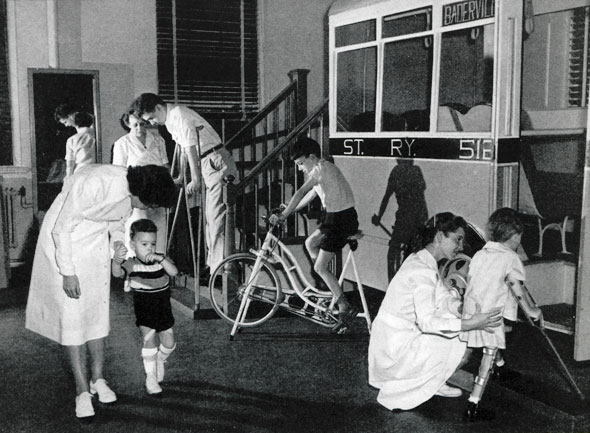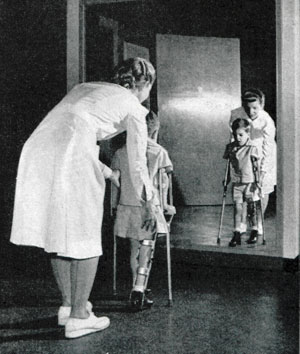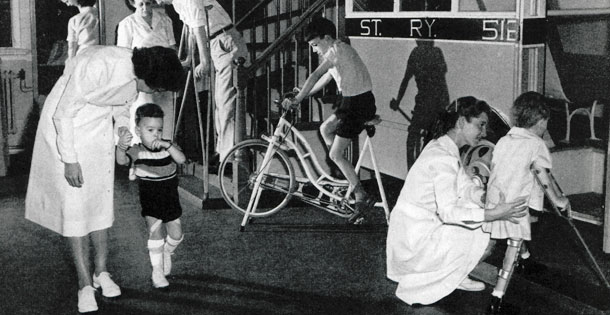
It had been a good year for Lois Mace.
She and her husband, only three years beyond college, had bought their first house. A solid redbrick and clapboard Cape Cod, it sat on a leafy street named for a character out of a Longfellow poem. In its driveway glistened a new sedan, silver-gray with a burgundy roof and whitewalls, a gift from her father, a Ford dealer.
And under its dormers that last day of August 1954 slept her three children: A sunny toddler with platinum-blond hair and a weak stomach sphincter, known around the house, mostly affectionately, as Miss Urp. A 3-year-old bruiser with a devilish twinkle in his eye, whom the neighbor nicknamed Meatball. Then there was the eldest, a lithe towhead with quick feet and an even quicker tongue — him they called Motormouth. He was set in a week’s time to walk the two blocks down the hill and start first grade at Nakoma Elementary School.
Everything was the way she liked it, under control.
(The prior sentence, the careful reader knows, is a signal, the gun hung on the wall in the first act, which must go off in the second. And it will — in the case of my mother’s story, in a way unknown to today’s parents facing decisions about whether to vaccinate their children.)
In the middle of that night, Lois was roused by sounds from the boys’ bedroom. Tucked under the shed roof at the back of the house, the room was stuffy with the heat of late summer. The older boy, who shared a bed with his little brother and a ratty blue bear, lay feverish and whimpering. Her husband carried the boy to the bathroom. He was too weak to stand and use the toilet.
The next day they drove him to the hospital for a spinal tap. The spinal fluid was cloudy. “During the past three or four days almost complete paralysis of both lower extremities and left upper extremity and trunk musculature has developed,” his doctor would write in the medical record on September 4.
Lois Mace Paul, 28, had come very far, very fast from a Depression-era childhood in a small Iowa town — husband, house, kids so well behaved that strangers would stop by the table in restaurants to compliment her. But now she was also the mother of a boy with polio. He lay in an isolation unit, afraid and confused, unable to sit or roll over. She could only stand in the doorway, swathed in a surgical gown and mask, forbidden to hold or comfort him for fear of spreading the virus.

We can safely assume these events counted as life-changing for Lois. After 10 days in isolation, the boy was put on a children’s ward, where he would remain for 130 days, “for institution of hot packs and passive stretching exercises and later institution of active exercises,” according to his medical record. Every afternoon at 2, Lois traveled the three miles to the hospital to sit with the boy. She would read to him as he ate the sandwich — always peanut butter on white bread — that she smuggled past the nurses; her boy wasn’t keen on hospital food. Her husband took the night shift, arriving at 7 to launch Pooh and Christopher Robin on their next “expotition.”
Even judged by the standard of today’s families balancing work and parenthood, the logistical challenges were daunting. Meals to make, clothes to wash and hang, diapers to change. Schedule babysitters for every afternoon. Change clothes and put on makeup — a respectable woman didn’t go downtown in jeans and without a face. Find a way to get back and forth; there was only the one car. Make dinner so her husband could get back to the hospital on time. Bathe and put the little ones to bed on her own. How much time or energy could there have been for coffee or cocktails with friends, or for nights out with her husband?
And it didn’t end there. When the boy was finally sent home, he had to be carried up and down stairs. Over the next decade there would be braces and crutches that he was always expensively outgrowing. And as he grew and his unbalanced muscles twisted his frame, Lois and her husband would sit eight times in a surgical waiting room while Dr. Wixson used chisel, hammer, wire, and staples to straighten the boy’s back and legs. Not until the boy himself waited outside an operating room as his own infant child underwent orthopedic surgery could he imagine how fear had shadowed Lois’ life.
Imagination is about all we have to tell us what those events meant to Lois emotionally. She didn’t talk much about feelings.
The boy’s only hint came one afternoon, about the time of his sixth birthday. A high school running back had injured his neck in a game and had been brought into the ward the night before, his limbs numb. As Lois and the boy looked on, a doctor and nurses, after some probing, helped the player sit, swing his legs off the bed, and, to the delight of staff and parents, stand again. Seeing what pleased adults, the boy turned to Lois. “I’m going to do that soon,” he said. She didn’t reply, but tears streamed down her face.
We know she grieved. Lois shared the bad news in a letter to her best college friend, who had joined the Iowa diaspora to Los Angeles. It read like a funeral notice. “Oh, my beautiful little boy,” she wrote in ending. Lois confided to her favorite aunt that she feared the boy would die.
Why didn’t Lois vaccinate me? Because she had not been given that choice. I had fallen ill 224 days before the announcement, on April 12, 1955, that the field trials of the Salk polio vaccine were a success.
As she lay in bed that night, digesting the news that had been shouted out across the country over radio, television, and public address systems in workplaces and schools, Lois had a choice to make. Because kicking inside her was the boy she had conceived in her grief the previous fall.
Today’s parents make those choices knowing much more than she did about the effectiveness and safety of the vaccines offered to their children. They can rely on decades of experience and scientific research.
Lois faced only scientific uncertainty. The Salk vaccine was new. It had been only 60 to 70 percent effective in the trial but had been deemed safe. Some of the world’s top polio researchers weren’t so sure. They had publicly opposed the trial, thought the vaccine the wrong approach, maybe even dangerous. Their fears materialized within weeks. Cutter Laboratories in Berkeley shipped vaccine contaminated with live virus. More than 200 children and family members were paralyzed, and 11 died. The vaccination campaign was briefly suspended.
But from her own experience, Lois Mace knew things that today’s parents, thanks to vaccines, have never had to learn — need never learn — about pain and grief and loss of control. As soon as she could, she took all her children to get the shots, and went back again after the Cutter fiasco.
She could not be certain it was the best choice for them. She knew, to her very bones, that it was the right choice for her.
Originally published at Zócalo Public Square (zocalopublicsquare.org).
Original article.
Become a Saturday Evening Post member and enjoy unlimited access. Subscribe now




Comments
In the early 1950’s my son came down with polio and all I can say is he was saved by the salk vaccination that he had received a month earlier.After post polio care and therapy he is now 61 yrs, old and still healthy I too had a decision to make about vaccination and I can only say that the vaccine no doubt saved him from being now diabled or worse,Mothers today do not know the diseases we had back then and if they put up a fuss about the measles vaccination,they are only doing harm to their child but also to children who come in contact with your unvaccinated child.Listen to the medical people who know about these things and get your child vaccinated for everyones sake.
In this day and time – there are some people who do not believe in vaccinations. They do not think disasters can occur again and put innocent people in danger. There is a current saying in the community. “If I cannot send my kid to school with a peanut butter sandwich – then do not send your kid to school without the proper vaccinations” Yes , there are exceptions – in that case – homeschool your children – that way your kid and mine are safe. – you are in the minority of decisions – to vaccinate or not to vaccinate. Thank you
I got polio in August 1944 when I was working at RICE’S BAKERY five and one half days a week. That Saturday when I delivered my sisters cakes they had ordered I was so tired I dozed-off for a few minutes and hurt so bad walking home that I was blinded by the pain, a car almost hit me as I crossed the street. I walked into my home and went to bed. That was the last time I walked! I was diagnosis with polio, spent 2 weeks in isolation and one year in Children’s Hospital for rehab. I was one of the many polio patients blood and saliava,spit, was used in the development of SALK VACCINE
I got polio while in the U.S. Navy September 1953. The Sick Bay tought it was just a mild case of flu, hecne they ordered me back on weekend duty. I was changing the fuid in hydraulic actuating cylinders on the jet airplanes for the Korean War. We changed it from oil based fluid to water based, as the oil based was catching fire. I used a sledge hammer with my right arm over my head to knock the pins out of the connections to the wing. On Monday I had a lot of pain, plus flu symptons. They took a spinal tap and said it was nothing but sent me home. I was in such pain that evening my neighbor took me to his doctor and the doctor was very concerned and wanted to give me a spinal tap. so I told him about the spinal tap results that morning. On Tuesday I had to report back and when I told them about the civilian Doc they took another tap and then would not let me out of bed and sent me to Oak Knoll Naval Hospital with the diagnosis of subaracknoid hemorage. (I learned later the first tap did have blood in it, but they misenterpreted it) When I got to Oak Knoll I had a definite weakness in my right hand and a corp man said to me, “Hell you’ve got polio!” That sure scared me and eventually my entire right arm was paralyzed. But I had a good young therapist guy (graduate of Western Kentucky State) and by January I was about well when they sent me back to duty as a sheet metal smith, which meant my job would require continued use of my right arm and hand. I am fine today. Mark’s article is a great message.
A moving and eloquent piece. Thank you Mark.